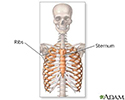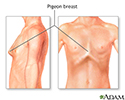Pectus carinatum
Pigeon breast; Pigeon chest
Pectus carinatum is present when the chest protrudes over the sternum. It is often described as giving the person a bird-like appearance.
Considerations
Pectus carinatum may occur alone or along with other genetic disorders or syndromes. The condition causes the sternum to protrude. There is a narrow depression along the sides of the chest. This gives the chest a bowed-out appearance similar to that of a pigeon.
People with pectus carinatum generally develop a normal heart and lungs. However, the deformity may prevent these from functioning as well as they could. There is some evidence that pectus carinatum may prevent complete emptying of air from the lungs in children. These young people may have less stamina, even if they do not recognize it.
Pectus deformities can also have an impact on a child's self image. Some children live happily with pectus carinatum. For others, the shape of the chest can damage their self-image and self-confidence. These feelings may interfere with forming connections to others.
Causes
Causes may include:
- Congenital pectus carinatum (present at birth)
-
Trisomy 18
Trisomy 18
Trisomy 18 is a genetic disorder in which a person has a third copy of material from chromosome 18, instead of the usual 2 copies.
 ImageRead Article Now Book Mark Article
ImageRead Article Now Book Mark Article - Trisomy 21
-
Homocystinuria
Homocystinuria
Homocystinuria is an inherited disorder that affects the metabolism of the amino acid methionine. Amino acids are the building blocks of life....
 ImageRead Article Now Book Mark Article
ImageRead Article Now Book Mark Article -
Marfan syndrome
Marfan syndrome
Marfan syndrome is a disorder of connective tissue. This is the tissue that strengthens the body's structures. Disorders of connective tissue affect...
 ImageRead Article Now Book Mark Article
ImageRead Article Now Book Mark Article -
Morquio syndrome
Morquio syndrome
Morquio syndrome is a disease of metabolism in which the body is missing or does not have enough of a substance needed to break down long chains of s...
Read Article Now Book Mark Article -
Multiple lentigines syndrome
Multiple lentigines syndrome
LEOPARD syndrome is a very rare inherited disorder in which there are problems with the skin, face, and heart.
 ImageRead Article Now Book Mark Article
ImageRead Article Now Book Mark Article -
Osteogenesis imperfecta
Osteogenesis imperfecta
Osteogenesis imperfecta is a condition causing extremely fragile bones.
 ImageRead Article Now Book Mark Article
ImageRead Article Now Book Mark Article
Home Care
No specific home care is needed for this condition.
When to Contact a Medical Professional
Call your health care provider if you notice that your child's chest seems abnormal in shape.
What to Expect at Your Office Visit
The provider will perform a physical exam and ask questions about the child's medical history and symptoms. Questions may include:
- When did you first notice this? Was it present at birth, or did it develop as the child grew?
- Is it getting better, worse, or staying the same?
- What other symptoms are present?
Tests that may be done include:
-
Lung function testing
to measure how well the heart and lungs are performing
Lung function testing
Pulmonary function tests are a group of tests that measure breathing and how well the lungs are functioning.
 ImageRead Article Now Book Mark Article
ImageRead Article Now Book Mark Article - Lab tests such as chromosome studies, enzyme assays, x-rays, or metabolic studies
A brace may be used to treat children and young adolescents. Surgery is sometimes done. Some people have gained improved exercise ability and better lung function after surgery.
References
Boas SR. Skeletal diseases influencing pulmonary function. In: Kliegman RM, Stanton BF, St Geme JW III, Schor NF, eds. Nelson Textbook of Pediatrics . 20th ed. Philadelphia, PA: Elsevier; 2016:chap 417.
-
Ribcage - illustration
The ribs connect on the front of the chest with the long flat sternum, or breast bone, and on the back with the vertebral column, creating a cage of protection for the lungs and heart.
Ribcage
illustration
-
Bowed chest (pigeon breast) - illustration
A bowed chest is also called pectus carinatum. It is a protrusion of the chest over the sternum often described as bird-like. Pectus carinatum is usually only a cosmetic defect but can be associated with other genetic diseases.
Bowed chest (pigeon breast)
illustration
-
Ribcage - illustration
The ribs connect on the front of the chest with the long flat sternum, or breast bone, and on the back with the vertebral column, creating a cage of protection for the lungs and heart.
Ribcage
illustration
-
Bowed chest (pigeon breast) - illustration
A bowed chest is also called pectus carinatum. It is a protrusion of the chest over the sternum often described as bird-like. Pectus carinatum is usually only a cosmetic defect but can be associated with other genetic diseases.
Bowed chest (pigeon breast)
illustration
Review Date: 7/10/2015
Reviewed By: Neil K. Kaneshiro, MD, MHA, Clinical Assistant Professor of Pediatrics, University of Washington School of Medicine, Seattle, WA. Also reviewed by David Zieve, MD, MHA, Isla Ogilvie, PhD, and the A.D.A.M. Editorial team.


